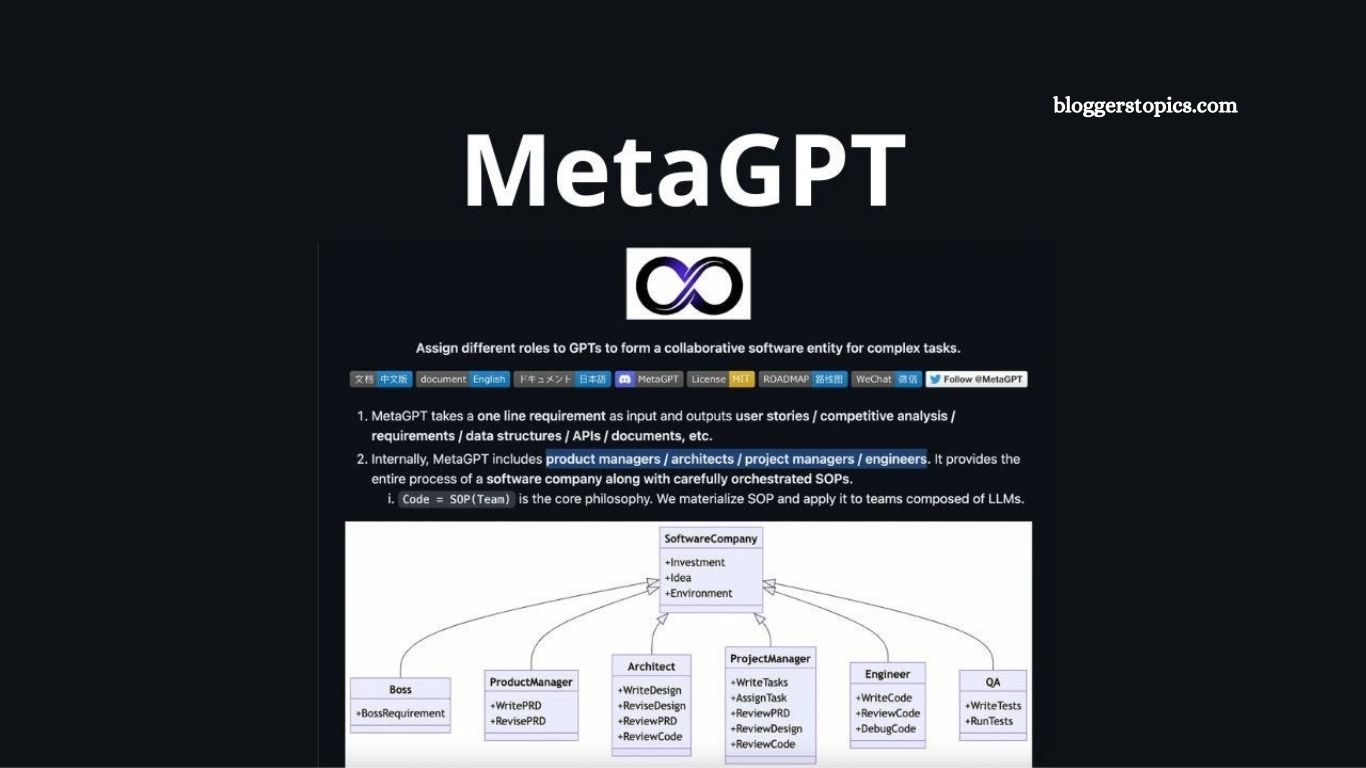Education has always adapted to new technologies, from chalkboards to computers, and now artificial intelligence. Once confined to science fiction, AI is becoming part of classrooms, labs, and everyday study habits. Among emerging platforms, MetaGPT stands out for its unique approach: it acts like a team of virtual experts. Instead of simply delivering answers, it guides learners through structured processes of planning, designing, and building projects
. This makes it especially valuable in education, where clarity and support are essential. Students, teachers, and researchers can use MetaGPT to explore AI concepts, develop software, and analyze data with greater ease. By working with AI agents that explain and demonstrate each step, learners can bypass the steep entry barriers of coding and focus on meaningful application.
Read More: What Defines a Good Assignment? Expert Insights from Assignment In Need Writers
How Does MetaGPT Work in Education?
MetaGPT supports learning by guiding students through the same structured cycle professional developers use. When a project begins, each AI agent takes on a specialized role. The Team Leader manages overall tasks, the Product Manager defines requirements, the Architect designs the system, the Engineer codes and deploys, and the Data Analyst processes information to generate reports.
By observing how these agents collaborate, students gain insight into real-world teamwork and project workflows. Instead of just seeing code appear, learners understand why it was written, how it functions, and where it fits within a larger system.
Why Is MetaGPT Important for Teaching AI?
Teaching AI is often difficult because it involves advanced mathematics, programming languages, and technical jargon. MetaGPT reduces these barriers by breaking tasks into step-by-step procedures executed by expert agents. This makes AI approachable for beginners while still offering advanced learners exposure to realistic practices like system design and project management.
For educators, MetaGPT can serve as a tool to design assignments, build interactive lessons, and demonstrate AI concepts in action. In short, MetaGPT transforms complexity into clarity—precisely what education should do when introducing new technologies.
How Can MetaGPT Assist Learners?
MetaGPT enhances learning by combining demonstration with hands-on practice. For example, a computer science student can prompt MetaGPT to build a small web application. The platform then illustrates each stage: the Product Manager defines requirements, the Architect organizes the system design, and the Engineer codes the solution. Students can study each step, make modifications, and learn through iteration.
Its value extends beyond technical fields. A business student might use MetaGPT to create a dashboard for tracking performance metrics, while a design student could generate a digital portfolio. Data science students can analyze datasets without writing every line of code. These experiences bridge the gap between theory and practice, allowing learners to apply AI meaningfully in their studies.
How Can Teachers Leverage MetaGPT in the Classroom?
For educators, MetaGPT can serve as a dynamic teaching assistant. Teachers can design guided projects where AI agents handle technical execution, while students focus on understanding the reasoning and logic. It can also generate real-time classroom examples, such as demonstrating how a code snippet is structured or how raw data is transformed into insights.
Assignments can be built around MetaGPT as well. A teacher might ask students to describe a concept in plain language and then observe how the AI agents convert it into a working project. This approach not only develops technical understanding but also emphasizes clear communication, critical thinking, and project planning—skills essential for both academic and professional growth.
What Real-World Examples Demonstrate MetaGPT in Education?
Several real-world examples highlight how MetaGPT is being applied in education:
- High school computer science classes use MetaGPT to guide students in building small applications, making programming fundamentals more accessible.
- College-level data science courses rely on the Data Analyst agent to process large datasets, allowing students to focus on interpreting results rather than handling repetitive coding.
- Business schools integrate MetaGPT into projects where students prototype inventory or sales-tracking apps, bridging theory with hands-on business applications.
- Design courses encourage students to create digital portfolios using the Engineer agent, demonstrating the synergy between design and development.
In each case, MetaGPT makes learning more interactive and experiential, giving students the opportunity to test, explore, and learn by doing.
How Do Students Get Started with MetaGPT?
Getting started with MetaGPT in education is straightforward and requires only a few steps:
- Log in to the platform.
- Choose the language model you want to use.
- Enter a prompt describing your question or project.
- Upload any supporting files or images if needed.
- Allow the AI agents to collaborate, each performing its specialized role.
- Review the generated output in the editor or preview section.
- Make edits, approve the result, and deploy or save it.
This streamlined process allows students to focus on learning while MetaGPT handles the technical execution, guiding them step by step from concept to completion.
What Are the Benefits of MetaGPT in Education?
MetaGPT offers a wide range of benefits for both students and teachers. One of the biggest advantages is time efficiency—teachers can deliver lessons more effectively, while students can explore projects without being slowed down by technical hurdles. Another major benefit is collaboration.
Students can work together on projects with MetaGPT serving as their shared development assistant, ensuring everyone sees how roles and responsibilities come together. This combination of speed, accessibility, and teamwork makes MetaGPT a powerful learning companion.
How Is MetaGPT Different from Other Tools in Education?
Most educational tools focus on one area, such as coding tutorials, online lectures, or data visualization platforms. MetaGPT is different because it brings all of these elements into a single system managed by specialized AI agents. Instead of only showing snippets of code, MetaGPT walks learners through the entire development process—from idea to execution.
Unlike tools limited to pre-built templates, it creates customized projects based on natural language prompts, giving students a personalized, real-world learning experience. This versatility sets MetaGPT apart as a unique platform for teaching and learning AI.
What Is the Future of MetaGPT in Education?
The outlook for MetaGPT in education is highly promising. As AI technology continues to advance, the platform will likely support more programming languages and tackle increasingly complex projects. This will allow students to build diverse skill sets within a single environment.
Beyond the technical side, MetaGPT reflects a larger shift in education—one where AI doesn’t replace teachers but partners with them to create dynamic, engaging learning experiences. Future generations will not only learn to use technology but will grow up learning with technology, preparing them for an AI-driven world.
Frequently Asked Questions (FAQs)
What is MetaGPT in education?
MetaGPT is an AI-powered platform that simulates a team of expert agents—such as a Product Manager, Architect, Engineer, and Data Analyst—to guide students and teachers through real-world project development.
How does MetaGPT help students learn AI?
Instead of just generating answers, MetaGPT demonstrates the entire workflow of building projects, showing learners why code is written, how systems are designed, and how everything fits together.
Do students need coding skills to use MetaGPT?
No. Beginners can start with simple prompts and learn step by step, while advanced students can dive deeper into coding, system design, and project management.
Can teachers use MetaGPT in the classroom?
Yes. Teachers can design guided projects, create interactive lessons, or assign tasks where students observe AI agents turning ideas into working solutions.
How is MetaGPT different from other educational tools?
Most tools focus on one area, like coding tutorials or visualization. MetaGPT is unique because it integrates multiple roles and processes, offering a full project lifecycle experience.
Is MetaGPT useful for non-technical fields?
Absolutely. Business students can build dashboards, design students can create digital portfolios, and researchers can analyze datasets without heavy coding.
What is the future of MetaGPT in education?
As AI evolves, MetaGPT is expected to support more programming languages, handle complex projects, and become an even more dynamic partner in teaching and learning.
Conclusion
MetaGPT is reshaping the way students and teachers interact with artificial intelligence. By simulating a team of expert agents, it not only simplifies complex concepts but also demonstrates real-world workflows that bridge theory with practice. Students gain confidence by experimenting with projects, while teachers benefit from a versatile tool that enhances lessons, assignments, and collaboration. Unlike traditional educational platforms, MetaGPT offers a holistic experience from idea to execution making AI more approachable and engaging for learners of all levels.







